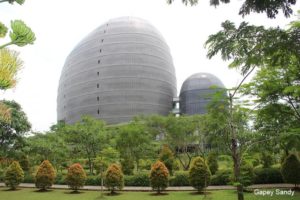
Universitas Multimedia Nusantara (UMN) contracted Synergy Efficiency Solutions (SES) to design a new low cost and energy efficient university campus. The new university building designed by Synergy Efficiency Solutions is using 49% less energy than the Indonesian University standard. UMN has been awarded "Most Energy Efficient New Building" by the Indonesian Ministry of Energy in 2013 and also recognized as "The Most Energy Efficient Building in South East Asia" by ASEAN in 2014.
SES is incorporating passive cooling systems, natural ventilation designs, and innovative natural lighting concepts in order to make UMN the first low-energy campus building in Indonesia. The designs are drafted using advanced modeling tools to determine the actual cooling load, optimal cooling technology, and capacity for sunlight. Besides drastically reducing the building's footprint, SES's design strategies result in comfortable temperatures, fresh air circulation, and natural lighting that will enhance the health and productivity of the students and staff. The building design also incorporates rainwater and black water capture and treatment for onsite reuse. A portion of the water is also used for groundwater recharge.
The following review of the design firm, SES, gives great background into their design philosophy: "When it designs new buildings, SES relies on software called EnergyPlus developed by the US Department of Energy. With EnergyPLus, SES creates precise 3D-models of the buildings its planning, simulating energy flows and testing reactions to all kinds of parameter changes."
Another detailed overview of the building's design features is available from Gapey Sandy at Kompasiana.
Savings Narrative:
SES estimates that the New Media Tower saves 49% over a traditional university building.
Further, SES was contracted by UMN to perform a campus-wide energy audit and implement a number of the recommendations through an ESCO (Energy Service Company) agreement, in which the firm performing the retrofit work is paid from a portion of the energy saved by the implemented retrofits; the client is guaranteed a savings and does not need to provide any capital for the project. This retrofit project yielded a 22% energy savings.